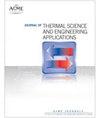Exergy Transfer and Irreversibility of Metal Foams Filled in a Vertical Channel
IF 1.4
4区 工程技术
Q3 ENGINEERING, MECHANICAL
引用次数: 1
Abstract
The aim of this work is to unveil the exergy transfer and overall thermal performance of the metal foams partially filled in varying thicknesses in the vertical channel. The numerical examination performed in this study consists of a heater cum plate assembly which is placed at the core of the vertical channel and the heat transfer from the plates is augmented by placing high thermal conductivity metal foams on either side of the channel. The novelty of the present investigation is to find the optimum filling rate in various thicknesses of the channel with respect to overall thermal performance along with exergy transfer. Four different partial filling rates are considered in each thickness of the channel to find the optimum exergy transfer. The integrated Darcy Extended Forchheimer (DEF) and local thermal non-equilibrium (LTNE) models are used for forecasting the flow features and heat transfer through the metal foam porous medium. The numerical methodology implemented in this research is confirmed by comparing the results with the literature and found a fairly good agreement between them. The flow physiognomies in terms of pressure drop and friction factor, heat transfer performance in terms of Nusselt number and performance factor, exergy transfer in terms of mean exergy based Nusselt number are presented and discussed. Results showed that higher working limits permitted by exergy (WLPERe) is obtained for lesser metal foam filling rate as well as for higher metal foam thicknesses for all the cases examined in the study.垂直通道中填充金属泡沫的火能传递与不可逆性
这项工作的目的是揭示在垂直通道中以不同厚度部分填充的金属泡沫的火能传递和整体热性能。在本研究中进行的数值测试包括一个加热器和板组件,该组件放置在垂直通道的核心,并且通过在通道两侧放置高导热性金属泡沫来增强来自板的传热。本研究的新颖之处在于找到不同厚度的通道中与总热性能和火用传递相关的最佳填充率。在通道的每个厚度中考虑了四种不同的部分填充率,以找到最佳的火用传递。采用Darcy Extended Forchheimer (DEF)模型和局部热非平衡(LTNE)模型对金属泡沫多孔介质的流动特征和传热进行了综合预测。通过与文献的比较,证实了本研究所采用的数值方法,并发现两者之间有较好的一致性。给出并讨论了基于压降和摩擦系数的流动面相、基于努塞尔数和性能因子的换热性能、基于努塞尔数的平均火用传递。结果表明,对于研究中所检查的所有情况,较小的金属泡沫填充率和较高的金属泡沫厚度获得了较高的工作极限(wlpee)。
本文章由计算机程序翻译,如有差异,请以英文原文为准。
求助全文
约1分钟内获得全文
求助全文
来源期刊

Journal of Thermal Science and Engineering Applications
THERMODYNAMICSENGINEERING, MECHANICAL -ENGINEERING, MECHANICAL
CiteScore
3.60
自引率
9.50%
发文量
120
期刊介绍:
Applications in: Aerospace systems; Gas turbines; Biotechnology; Defense systems; Electronic and photonic equipment; Energy systems; Manufacturing; Refrigeration and air conditioning; Homeland security systems; Micro- and nanoscale devices; Petrochemical processing; Medical systems; Energy efficiency; Sustainability; Solar systems; Combustion systems
 求助内容:
求助内容: 应助结果提醒方式:
应助结果提醒方式:


